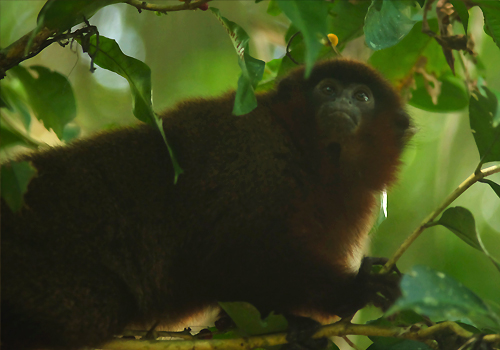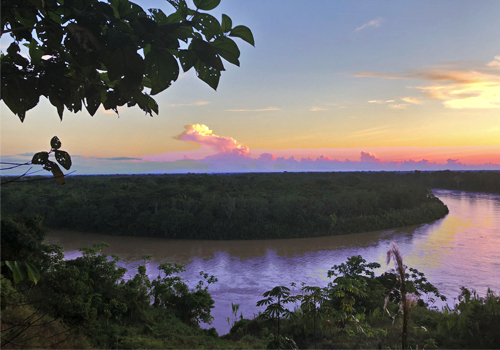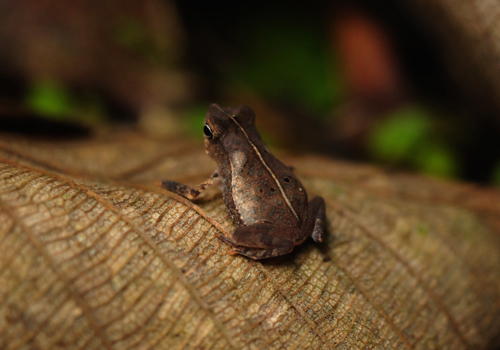Summer is the perfect time for students to travel the world, gain real-world experience or continue their studies through summer courses. Last month, 20 undergraduate students enrolled in Megan Frederickson and John Stinchcombe’s Tropical Field Biology course got to do all this at once – and experience remote and biodiverse ecosystems that few people ever get to see.
The fourth-year course, offered by the Department of Ecology and Evolutionary Biology in the Faculty of Arts & Science, gives students the unique opportunity to conduct both group and independent field research in the Andean and Amazonian regions of Peru.
During the two-week trip, students first spent several days at the Wayqecha Cloud Forest Biological Station, located almost 3,000 metres above sea level on the eastern slope of the Andes Mountains. They then voyaged to the Los Amigos Research Center, in the Amazon Basin, where they explored the surrounding lowland tropical rainforest.
Now that they’ve returned home, A&S News caught up with some of the students and their professors to ask about their experience in Peru.
How did the trip compare to what you’ve been learning in the classroom?

“There’s no comparison. The ability to connect what you are being taught with an experience solidifies what you are learning so much more than sitting in a lecture hall.”
– Sebastian Warma, a first-year student at Trinity College taking a double major in neuroscience and economics.
What were you looking forward to most in Peru?
“Looking at the insect diversity in the Amazon and trying to interpret it in an evolutionary and ecological context. I also have an interest in edible plants, food science and anthropology and Peru is one of the original places of cultivation of very diverse fruits and vegetables. The Amazon is very rich in edible, useful, medicinal and ritual plants.”
– Jesse Huisken, a third-year student at Innis College majoring in ecology and evolutionary biology with a minor in environmental biology and environmental anthropology.
What was your favourite part of the trip?
“Besides observing all the interesting things that make up tropical ecology, my favourite part was the travel between biological stations – by van and by boat – and seeing the contexts in which the ecosystems are situated and the communities that live around them: Andean mountain roads with sheer drops to one side, small towns, bustling markets, colourful cultural clothes, remnants of gold mining operations, and adorable street dogs!”
– Angela Gu, a fourth-year student at Trinity College taking a double major in ethics, society and law and French language and literature, with a minor in environmental biology.
Did anything surprise you during your time abroad?

“I was mainly surprised by the rainforest itself. I had never been outside of North America prior to this trip so it was quite an astonishing sight.”
– Kelsey Crocker, a third-year student at New College studying fundamentals of genetics and its applications and ecology and evolutionary biology.
What do you think you’ll take away from this experience?
“The difficulty of working in a different country with people that speak another language is a very sobering experience. However, you realize that people around the world are not all that different from you. Working with researchers and conservationists in Peru was an amazing experience because it helps you realize that the fight against climate change is truly a global one.”
– Raj Vansia, a fourth-year biology student visiting the Faculty of Arts & Science from McMaster University.
Would you recommend this experience to other students?
“This experience was great and I would definitely recommend it to other students, and not necessarily only those in ecology and evolutionary biology. From paper discussions to student-led mini lectures, this course teaches many skills that are transferable to any lab setting (and beyond). In addition, you end up making lots of good friends, have some opportunities to network, and get to see some amazing sights to boot!”
– Kevin Anderson, a fourth-year New College student specializing in ecology and evolutionary biology.
What do you hope your students took away from this experience?

“I hope the students gained an appreciation for tropical biodiversity. They learned first-hand just how hard it is to identify plants and animals in the tropics, because there are so many thousands of species. And by visiting cloud forest in the Andes and lowland rainforest in the Amazon Basin, they got to see that the “tropics” is not just one habitat type, but instead encompasses many different ecosystems.”
– Associate Professor Megan Frederickson.
How did the trip compare to what you’ve been teaching in the classroom?
“The highlight of all field teaching for me is independent projects that students do at the end of the course. Instead of getting received wisdom, or knowledge developed and explained by others, they are responsible for trying to figure something out on their own! It’s much, much closer to how we really do science than anything you’ll experience in a lecture hall, and in my experience students really love it.”
– Professor & Director, Koffler Scientific Reserve John Stinchcombe.

